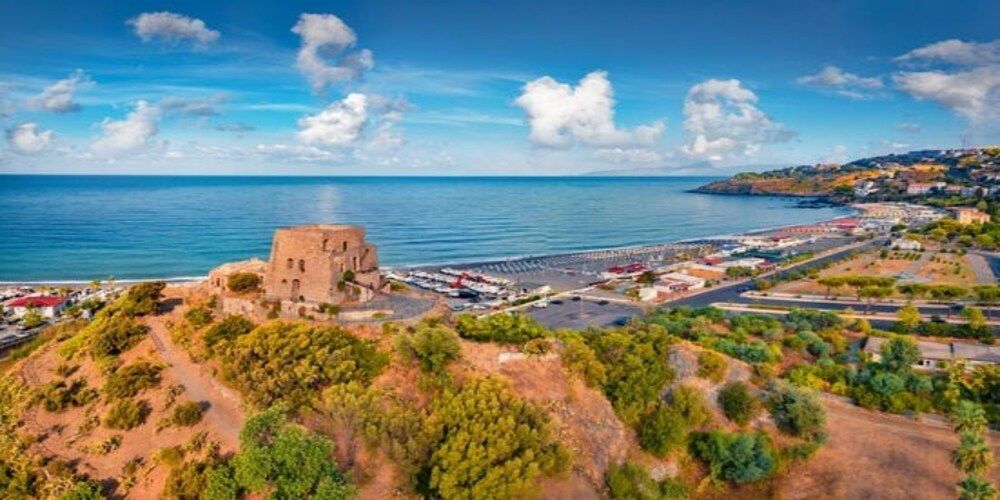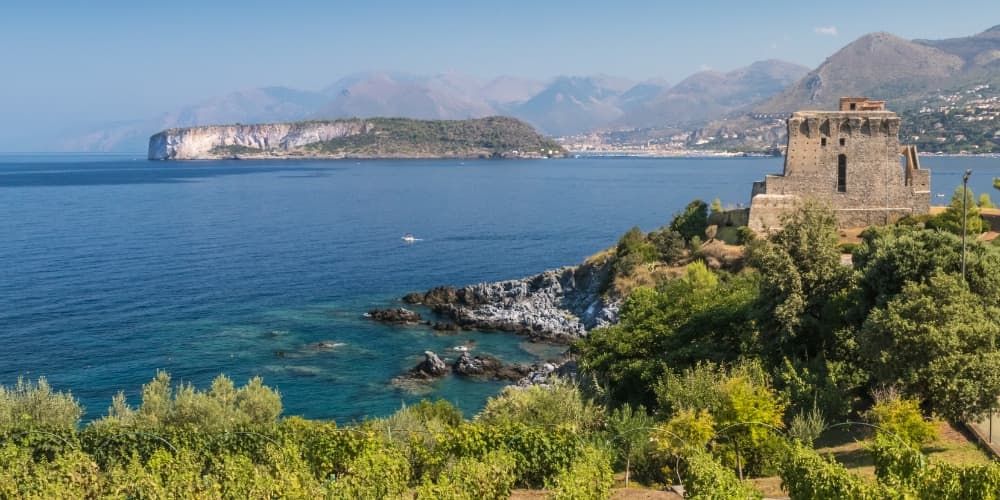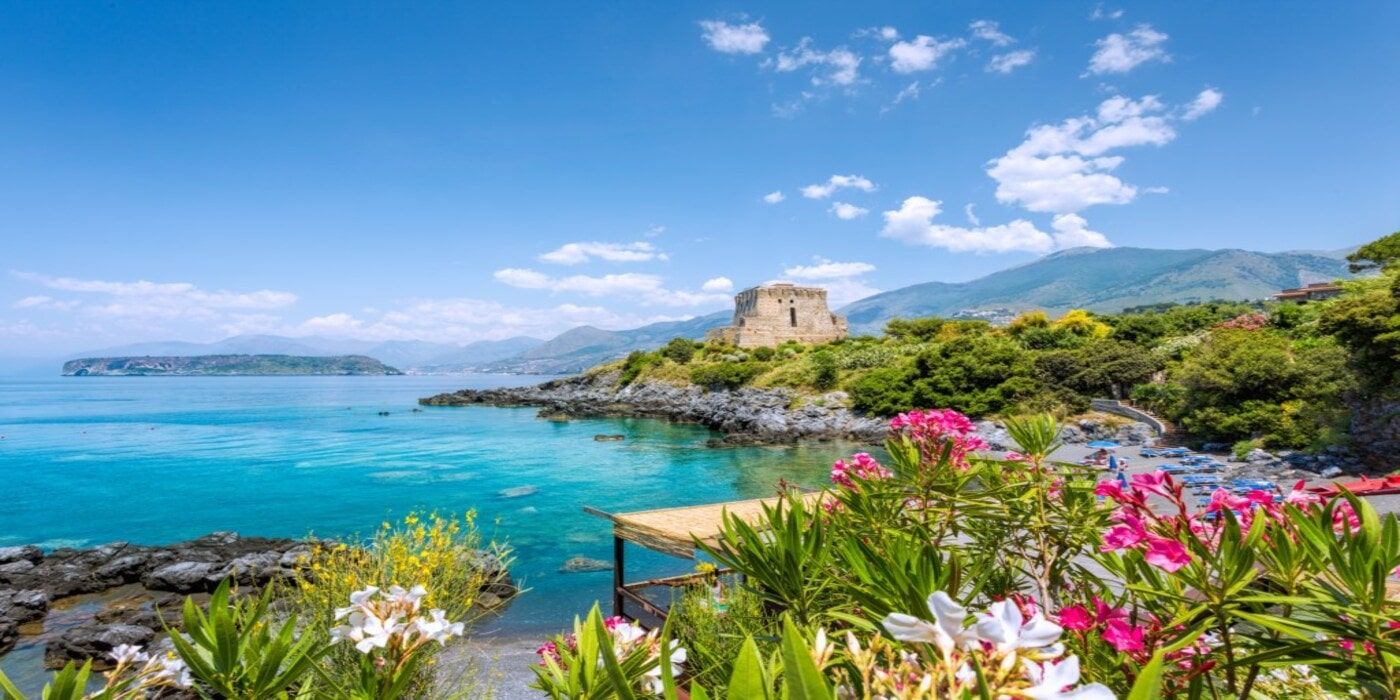In the northern part of Calabria, in the province of Cosenza, lies a portion of about 50 km of coastline, overlooking the Tyrrhenian Sea and ideally embracing the Pollino National Park on one side and the Regional Marine Park “Riviera dei Cedri” on the other - respectively, the natural area of Mount Pollino and the protected marine area including the coastline and the islets.
Here nature rules, the sea and the mountains, the blue and the green, come together, there are ideal conditions for the spontaneous growth of cedars, perhaps the region's most representative citrus fruits.
And it is they who give their name to this piece of coastline that gives us wonderful views and offers fertile ground for extraordinary experiences. Come with us to discover Riviera dei Cedri (the Cedar Coast) and the urban realities that are part of it.

Among nature and enchanting villages: the essence of the Riviera dei Cedri

Along the Riviera dei Cedri and in the surrounding territories, as mentioned, nature takes center stage. For those who love the sea, the undisputed symbol of the Calabria region, but also for those who love mountains, this area can offer relaxation, adventure and dreamy views just waiting to be photographed. But it is also an area rich in history and culture, to be traveled, visited and discovered. Twenty-two municipalities are part of the Riviera, some well-known seaside tourism centers, such as Scalea, Diamante and Praia a Mare, and others that are not so famous; for this reason, they should not be left unexplored.
The project Riviera dei Cedri La Porta della Calabria was created to introduce the hidden corners of Calabria to those who do not know this enchanting region yet; it guides travelers on tours and experiences beyond the usual tourist routes and enjoy the true essence of locations, thanks to the collaboration between Consorzio ECOtur, Arca, the Italian Chili Pepper Academy, further tour operators, and a network of carefully selected tourism providers.
Today we want to suggest a 8-day tour to discover 17 of the 22 towns of the area, drawing inspiration from the eco-sustainable and green philosophy tour operators network and proposing a series of activities that will allow you to get to know the area authentically, in person.
The destination can be reached by car from the nearest airport, Lamezia Terme, which is about 120 km away. Set out with us to discover the Riviera dei Cedri.
Discover more about I Viaggi dell'ArcaDay 1: Tortora and Aieta
For our first day we will explore 2 municipalities, Tortora and Aieta - the former earned the Blue Flag 2025 and the latter listed among Italy's Most Beautiful Villages. Once we arrive at the airport, we will rent a car and set off for our first destination, which is about two and a half hours away.
Just 10 km from the sea, Aieta is an enchanting little town to walk around, with its numerous churches and hand-crafted stone portals adorning the picturesque alleys. Noteworthy here is the centuries-old textile tradition, which is still practiced today by skilled weavers using ancient machinery. The art of weaving provides traditional garments made with care and attention to detail, which can be purchased as unique souvenirs. In addition, for a delicious culinary experience, you can try the poverello bean, a typical local variety used to make tasty dishes, including first courses and soups.
Let's move along the coast and in about 20 minutes we arrive in Tortora. This municipality of about 5,000 inhabitants is so named, apparently, because of the presence of the bird of the same name, which finds an ideal habitat here and is depicted on the town coat of arms. Here, in addition to enjoying the beach and the sea, you can stroll through the charming old town, full of picturesque streets, or visit the Blanda Archaeological Museum. The museum houses a series of historical artifacts and presents multimedia reconstructions of the eras and populations that have succeeded one another in Tortora, from the Greeks to the Romans, from the Carthaginians to the Lombards.
Tortora offers plenty of tasteful delights, such as zafarana, a variety of thin, long red pepper that, when dried and crumbled, takes center stage in flavorful first courses, main dishes, and side dishes.
Day 2: Praia and San Nicola Arcella
For our second day, we stay on the coast and drive about 3 km to Praia a Mare, a popular seaside destination. With its sandy beach stretching for about 5 km, it offers a corner of paradise to enjoy some relaxation.
Nature lovers and the more adventurous can visit the “secret” places found here, such as the caves of Dino Island off the coast of Praia, and the famous Grotta Azzurra, so called because of the characteristic color of its walls. You can also visit the Torre di Fiuzzi, formerly used as a watchtower, and the Sanctuary of the Madonna della Grotta, at the top of a series of steps. It is a place of prayer and meditation inside three rock cavities, where natural light creates a mystical atmosphere.
In just 5 minutes, we arrive at San Nicola Arcella, another Blue Flag beach and a town rich in wonders for this itinerary to discover the Riviera dei Cedri.
Here too, the sea is the main attraction, inspiring us to explore the bay by boat or pedal boat. From Marinella beach, the most representative of the area, you can reach Dino Island; from here you can see the noble palace of the Lanza Princes, an example of Baroque architecture now used as a resort and event venue.
By boat, you can also admire the picturesque Arcomagno, or Grotta del Saraceno, a natural stone arch that will provide you with splendid photos at sunset. If you prefer to explore the seabed, you can go snorkeling among the rocky walls and surround yourself with the blue of the Tyrrhenian Sea.
Finally, for hiking enthusiasts, it is possibile to reache the Crawford Tower. Coastal trails take you to this picturesque 16th-century Saracen tower, which was the home of writer Robert Francis Marion Crawford from the late 19th to early 20th century and became the subject of many of his literary works.
Day 3: Scalea and Santa Domenica Talao
Another beloved vacation spot, Scalea offers unspoiled beaches, crystal-clear sea and everything relaxing and fun that is required for a vacation. We reach it in just a 10-minute drive and are immediately captivated by its peculiar conformation: a spur of rock where the urban agglomeration plunges into the sea as if descending from a ladder.
You can also catch a glimpse of a series of majestic-looking cliffs, resembling mythological creatures looking out from the water, of what is known as Baia del Drago, Dragon Bay. Here you can also explore, either by swimming or by boat, a series of coves, such as the Baia del Carpino, the Spiaggetta, and the Piscina, as well as caves, such as the Baia della Pecora.
But if all this natural beauty is not enough for you, know that you can explore the surroundings with trekking routes at various levels and come across a number of historic buildings, such as the Talao Tower, an example of Aragonese military architecture from the 16th century, or the Norman Castle.
Even on the table, sea is a protagonist, especially in anchovies-based dishes. Anchovies are typical in Scalea - they are pickled, fried, in breadcrumbs or with pasta.
Let's move on to Santa Domenica Talao, another charming inland village about 11 km away, bathed by the Lao River.
Here too, ancient traditions persist, and wandering through the picturesque alleys of the historic center, you can visit the Museo della Terra (Museum of the Earth), which tributes local customs and rural life. You can also enjoy the stunning view from Piazza Italia, a meeting place for locals, where you can marvel at the Mediterranean Sea and the entire Riviera dei Cedri.
On the tables of Santa Domenica Talao, you can find several varieties of local black truffles and the typical dessert, gnoccolo or turdillo, a particular sweet striped dumpling made with vincotto dough and covered with honey and colored sprinkles.
Day 4: Papasidero e Orsomarso
For our second day, we reach two notable destinations inland: Papasidero and Orsomarso.
About 50 minutes from Tortora, Papasidero is a tiny village of just 500 inhabitants nestled in the green of the Pollino National Park, atop Mount Ciagola. This tiny place hides a number of must-see wonders, such as the Grotta del Romito, a UNESCO site renowned for its Paleolithic rock carvings, or the Sanctuary of the Madonna of Constantinople, which sits atop a rock face on a bank of the Lao River.
But the river is definitely the main attraction of Papasidero, because there is a splendid nature reserve around it, perfect for hiking, walking, sessions in the adventure park, but also for those who like to challenge the water: here you can in fact take canoe and rafting tours that will add a pinch of adrenaline to your stay.
Orsomarso, our next destination, is nestled in the mountain range of the same name and is also crossed by a river, the Argentino. We reach this village of 1,000 inhabitants in about 25 square kilometers and discover the beauty of the Argentino Nature Reserve, a UNESCO site rich in unique plant and animal species - such as the roe deer and peregrine falcon - that can be spotted with a bit of luck.
Hiking and walking are a must here, especially across important sacred sites: here is the Cave of the Virgin of Lourdes, inside which is a 3-meter statue of the Virgin, commemorating the centenary of the apparitions in the French town.
It is also possible to admire the Clock Tower, a priceless testimony to the Mercurion, an area straddling Basilicata and Calabria where Greek-Oriental Basilian monks prospered in the 6th century. The tower was actually the apex of a monastery located here, and today it is an excellent viewpoint to admire the beauty of the Pollino.
Unmissable in Orsomarso is the exquisite fusillo, a long, thin type of fresh pasta prepared with a special iron rod and seasoned with mutton or veal and pork ragù. It is the star of a festival held in August.
Day 5: Verbicaro and Santa Maria del Cedro
Our fifth day continues in Verbicaro, about 40 km away from Bonifati. This charming village ideally combines the views of the Pollino with those of the Riviera, of which Marine Park is an integral part, providing breathtaking views and full immersion experiences in nature for travelers of all kinds.
Verbicaro is also known as the “City of Wine,” because of the production of its AOC red wine. Wandering around the town, you 'll come across the many local wineries - anciently catuvo - and enjoy a glass of the delicious nectar produced here, which can be easily paired with local strong-flavored dishes. The long history of Verbicaro wine can be learned in the Museum of Wine and Peasant Life, which displays all the tools useful for wine production and a number of relics related to rural culture.
Another typical local product are panicelli, fragrant square-shaped sweet bundles wrapped in cedar leaves and filled with raisins and candied cedar, a fruit that grows here.
With a 20-minute drive we finally arrive on the coast, in Santa Maria del Cedro, a famous seaside tourism center that won the Blue Flag for the fifth year in a row. It rises on the slopes of Cozzo del Pellegrino, which is part of the massif of the Orsomarso Mountains, is embraced by the Lao River. Most importantly, it will give you among the most beautiful sunsets over the sea of your life.
The town experienced its tourism boom starting in the 1980s but is a must-see destination at any time of the year, not just in summer. Indeed, there are countless areas to visit, such as the archaeological excavations of the ancient city of Laos from the Magna Graecia period.
However, crucially important is the fruit that gives the village (and the portion of the coast) its name: the cedar.
It is not only at the heart of many culinary preparations, such as liqueurs, jams, and preserves, but also the essence of the connection between this place and Jewish culture: in July and August, rabbis from all over the world come to Santa Maria to harvest cedars, a clear homage to those mentioned in the Bible. These will be used in October to celebrate the Feast of Tents, the Sukkot.
The cedar is also the protagonist of a museum entirely dedicated to it, which explains the history and virtues of this fruit, as well as the essential steps for its processing.
Day 6: Grisolia and Maierà
We begin our sixth day exploring the Riviera dei Cedri in Grisolia, 7 km from Santa Maria del Cedro. This town has about 2,000 inhabitants and features a historic center perched at an altitude of over 400 meters and a beach area by the sea. The historic center is a maze of stone alleys that, in some areas, offer a privileged view of the shoreline, while the beach area is one of the most popular vacation spots.
Heading inland, in the Pollino National Park, you can enjoy interesting trekking routes, admiring the majestic trees in the area - chestnut and oak trees, but above all the Loricato pine, typical of the Pollino landscape.
The nearby village of Maierà, a 10-minute drive away, is located in the picturesque Valle dei Mulini, Mills Valley. Still present and visible today, the stone mills certainly represent the heart of a special, evocative landscape, as well as evidence of the long local milling tradition.
The name probably derives from the Hebrew M'arà, cave, because inside the numerous cavities in the area Jews took refuge to escape persecution and Basilian monks settled to pray. Maierà is therefore a fascinating place, for those who love mountains and original places to visit, but it is also a center of great importance for its gastronomy. In fact, the delicious diavolillo pepper is grown here, the protagonist of numerous dishes and even a museum dedicated exclusively to it.
But you can also enjoy first courses of fresh hand-rolled pasta with goat meat sauce, with chickpeas and many other delicacies to accompany a full-bodied glass of local wine. Of course, if you want to learn how to prepare these delights, you have the chance to attend show cooking and workshops held by locals.
Day 7: Diamante e Buonvicino
Let's continue our journey discovering the Riviera dei Cedri by returning to the sea. For our seventh day we move about ten kilometers to arrive at another resort that needs no introduction: Diamante.
Also a Blue Flag town, Diamante is known for its production of chili peppers and home to the Peperoncino Festival, a must-attend summer event. But it is also known as the “City of Murals” because since the 1980s street artists have been meeting there to decorate the walls of its buildings with beautiful works of art.
If you love the sea, however, you can't miss a trip to nearby Cirella Island, a sheer rocky outcrop resembling a whale, around which you can explore the deep sea and various coves with snorkeling sessions. Also not to be overlooked is the lively nightlife on the beach and in town, perfect for younger people who want to have fun after a day at the beach.
If Diamante is an ideal choice for exploring the beauty of the Tyrrhenian Sea, Buonvicino isn't different. Located just a 10-kilometer drive from Diamante, it is part of the Italy's Most Beautiful Villages, thanks to its well-preserved 14th-century historic center, composed of nobility palaces and noteworthy buildings. The natural beauty surrounding it is also to be considered, which is rich in hiking trails and waterways of the Corvino stream, where you can admire up to 50 different species of wild orchids.
Day 8: Belvedere Marittimo, Sangineto e Bonifati
We have finally arrived at the end of our journey to discover the Riviera dei Cedri and its charming villages. For our last day, we first head to Belvedere Marittimo.
We reach the beautiful beaches of the village in just 20 km and we are charmed by its unique landscapes. Besides the sea and the beach, we find a series of clayey ravines, authentic natural stone sculptures created by erosion and atmospheric phenomena. Furthermore, you cannot miss a visit to the beautiful Aragonese Castle.
But Belvedere is also a romantic place: it is known as the City of Love because it hosts the relics of Saint Valentine, the patron saint of lovers.
We travel about 10 km to discover Sangineto. Embraced by the Pollino National Park, it also has a seaside area, making it an ideal destination for those who love mountains and hiking as well as those who prefer beaches and relaxation.
There are many routes to follow here, such as those taking in historic residences (above all the Prince's Castle) or religious buildings (there are many churches and sanctuaries); but we would like to recommend the Sentiero dei Sogni (Path of Dreams), a 6 km trail surrounded by greenery that leads to the famous Vuglio Waterfall. Located inside a cave, it will make you dream with its natural light effects and fairytale atmosphere.
We complete our journey in Bonifati, just under 5 km from Buonvicino. Located in a hilly and mountainous setting, it is surrounded by two hills, the ruins of the Angevin-era castle of Bonifati, and several coastal towers - the most famous are the Torre di Parise, the Torre del Capo, and the Torre di Fella - which recreate a charming and evocative atmosphere.
The authentic Calabria through the Ceder Coastline

If you knew Calabria so far only for the sun&sea combo, we are sure you will now visit this beautiful region with different eyes and during every season.
By exploring the smaller towns and often off the classic tourist routes of the enchanting Cedar Riviera, as you may have seen, you can discover its natural, historical and traditional beauty and return home with a suitcase full of unforgettable memories.
About the author
Written on 16/07/2025



Denise Penna
A piece of Calabria plunging into the sea, villages rich in history and a citrus scent: come with us to discover the Riviera dei Cedri.